List of marine aquarium invertebrate species
This is a list of various species of marine invertebrates, animals without a backbone, that are commonly found in aquariums kept by hobby aquarists. Some species are intentionally collected for their desirable aesthetic characteristics. Others are kept to serve a functional role such as consuming algae in the aquarium. Some species are present only incidentally or are pest species.
Annelids
| Common name(s) | Image | Taxonomy | Reef safe | Care Level | Description | Max size |
|---|---|---|---|---|---|---|
| Christmas tree worm[1] |  |
Spirobranchus giganteus | Yes | Expert | Found living anchored in live coral colonies in nature. Each worm has two crowns, which come in a variety of different colors, and are spiraled in the shape of a Christmas tree. | 5 cm (2.0 in) |
| Cluster duster[1] |  |
Bispira brunnea | Yes | Moderate | This species grows in groups of up to 100 individual tube worms, living together in a single clump. The clusters of tubes adhere to a rocky substrate at a central point.[2] | 2.5 cm (1.0 in) |
| Feather duster worm, Fan worm[1] |  |
Sabellastarte sp. | Yes | Easy to Moderate | A sedentary (but it can scoot around), tube dwelling worm with a fan-shaped crown (radiole) that projects from the end of the tube. This can be white, tan, orange, sometimes with striping. They build their tubes out of sand, mud, and bits of shell. | 20 cm (7.9 in) |
Arthropods
Cheliceratas
| Common name | Image | Taxonomy | Reef safe | Care Level | Description | Max size |
|---|---|---|---|---|---|---|
| Atlantic horseshoe crab |  |
Limulus polyphemus |
Yes, with caution | Easy | A bottom dwelling animal that is actually not a true crab. Found burrowing in mud or sand flats in the wild, they need a deep sand bed in their aquarium. | 60 cm (23.6 in) |
| Sea spider[3] |  |
Pycnogonids |
No | Not collected for the aquarium trade, but occasionally seen on live rock and corals as a hitchhiker. They can be pests in a reef tank, preying on soft coral, sponges and anemones. | 0.2–50 cm (0.1–19.7 in) |
Crustaceans
| Common name | Image | Taxonomy | Reef safe | Care Level | Notes | Max size |
|---|---|---|---|---|---|---|
| Anemone crab |  |
Neopetrolisthes maculatus | Yes | Easy | It lives in anemones. Also a filter feeder | |
| Arrow crab |  |
Stenorhynchus seticornis | with caution | |||
| Hermit crabs |  |
Paguroidea sp. |
Will eat snails | Easy | ||
| Emerald crab |  |
Mithraculus sculptus | With caution? | Easy | May eat fish | |
| Pom-pom crab |  |
Lybia tessellata | With caution? | Easy? | ||
| Sally lightfoot crab |  |
Percnon gibbesi | With caution? | Easy? | ||
| Spider decorator crab |  |
Camposcia retusa | With caution? | Easy? | Will get some polyps to use for cover. | |
| Spiny lobster |  |
Panulirus versicolor | ||||
| Brine shrimp | 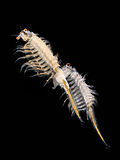 |
Artemia salina | Yes | Easy | Kept not as livestock, but rather to feed inverts and fish. | |
| Sexy shrimp |  |
Thor amboinensis | Yes | Easy | ||
| Snapping shrimp |  |
Alpheidae sp. | With caution? | Will make loud snapping sounds. | ||
| Peacock mantis shrimp |  |
Odontodactylus scyllarus | with caution | Easy | Will eat shelled things and possibly fish. Some people say they will redecorate their tank including moving corals but people have successfully kept them in reef tanks. Not a true shrimp but a stomatapod with the smashing raptorial appendage | |
| Coral banded shrimp |  |
Stenopus hispidus | Yes | Easy | Will eat small fish, in the wild they set up cleaning stations | |
| Camel shrimp |  |
Rhynchocinetes durbanensis | Yes | Easy? | Will nip on soft corals. | |
| Harlequin shrimp |  |
Hymenocera sp. | Will eat starfish | Moderate? | Will only eat starfish. | |
| Peppermint shrimp |  |
Lysmata wurdemanni complex | Yes | Easy | some people think they eat coral but only eat dying coral giving the appearance of eating healthy corals | |
| Skunk cleaner shrimp |  |
Lysmata amboinensis | Yes | Easy | Will clean dead tissue and remove parasites from fish. |
Corals
Corallimorphs
| Common name(s) | Image | Taxonomy | Temperament | Care Level | Description | Max size |
|---|---|---|---|---|---|---|
| Jewel anemone |  |
Corynactis viridis | ||||
| Knobbly mushroom coral, Florida false coral[4] |  |
Ricordea florida | ||||
| Knobbly mushroom coral, Yuma mushroom coral[4] |  |
Ricordea yuma | Semi-aggressive | Moderate | ||
| Mushroom coral, Mushroom anemone, Disk anemone[4] |  |
Discosoma sp. | Semi-aggressive | Easy | ||
| Strawberry anemone |  |
Corynactis californica |
Hydrocorals
| Common name | Image | Taxonomy | Temperament | Care Level | Description | Max size |
|---|---|---|---|---|---|---|
| Lace coral[5] |  |
Distichopora sp. | ||||
| Fire coral[5] |  |
Millepora sp. |
Large-polyp stony
| Common name(s) | Image | Taxonomy | Temperament | Care Level | Description | Max size |
|---|---|---|---|---|---|---|
| Black sun coral[6] |  |
Tubastraea micrantha |
Expert | |||
| Bubble coral |  |
Plerogyra sinuosa | Aggressive | Easy | ||
| Candy cane coral |  |
Caulastrea furcata |
Peaceful | Easy | ||
| Elegance coral[7] |  |
Catalaphyllia jardinei |
Aggressive | Moderate | ||
| Flowerpot coral | 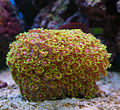 |
Goniopora sp. | Aggressive | Difficult | ||
| Frogspawn coral[8] |  |
Euphyllia divisa | Aggressive | Moderate | ||
| Hammer coral, Anchor coral[8] |  |
Euphyllia ancora | Aggressive | |||
| Lobed brain coral |  |
Lobophyllia hemprichii | Semi-Aggressive | |||
| Open brain coral |  |
Trachyphyllia geoffroyi |
Semi-aggressive | |||
| Pineapple brain coral, Moon coral | 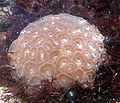 |
Favia sp. | Aggressive | |||
| Sun coral, Orange cup coral[9] |  |
Tubastraea sp., often Tubastrea aurea | Peaceful | Expert | ||
| Torch coral |  |
Euphyllia glabrescens | Aggressive | |||
| Whisker coral, Duncan coral[10] |  |
Duncanopsammia axifuga |
Peaceful | Easy |
Small-polyp stony
| Common name | Image | Taxonomy | Temperament | Care level | Description | Max size |
|---|---|---|---|---|---|---|
| Pink bird's nest coral[11] |  |
Seriatopora hystrix | ||||
| Cauliflower coral |  |
Pocillopora sp., usually Pocillopora damicornis | ||||
| Dimpled encrusting Montipora |  |
Montipora verrucosa | ||||
| Finger coral[12] |  |
Montipora digitata and Montipora samarensis | ||||
| Millepora coral, "Milli" coral |  |
Acropora millepora | Peaceful | Moderate | A popular and readily available species that comes in many color forms. It should not be confused with fire corals of the genus Millepora . |
|
| Plating montipora |  |
Montipora capricornis |
Peaceful | Moderate | ||
| Staghorn coral[13] |  |
Acropora cervicornis |
Peaceful | Difficult | A very rare species, it is generally not available to the average hobby aquarist due to its critically endangered status. It would make a good aquarium specimen, but can only be obtained with a special license. |
Soft corals
| Common name(s) | Image | Taxonomy | Temperament | Care Level | Description | Max size |
|---|---|---|---|---|---|---|
| Cabbage leather coral |  |
Sinularia brassica and Sinularia dura | Semi-aggressive | Easy | ||
| Clove polyps, Daisy polyps[14] |  |
Clavularia sp | Peaceful | Easy | ||
| Devil's hand leather coral |  |
Lobophytum sp. | Peaceful to Semi-aggressive | Easy | ||
| Finger leather coral |  |
Sinularia sp. | Semi-aggressive | Easy | ||
| Jasmine polyps, Daisy polyps |  |
Knopia | Peaceful | Easy | ||
| Pulse coral, Pulsing Xenia |  |
Xenia sp. |
Peaceful | Easy | An easy to care for coral known for its prolific asexual reproduction and polyps that actively move their tentacles in a pulsing motion. | |
| Red chili coral | 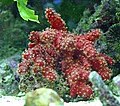 |
Nephthyigorgia | Peaceful | Expert | ||
| Spaghetti leather coral | 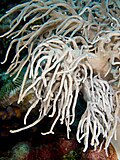 |
Sinularia flexibilis | Semi-aggressive | Easy | ||
| Star polyps[14] |  |
Clavularia viridis, Pachiclavularia viridis, or Briareum violaceum (taxonomy uncertain) | Peaceful | Easy |
Zoanthids
| Common name(s) | Image | Taxonomy | Temperament | Care Level | Description | Max size |
|---|---|---|---|---|---|---|
| Stick polyps, Tree polyps |  |
Acrozoanthus | ||||
| Button polyps, Zoanthids, "Zoas" |  |
Zoanthus | Semi-aggressive | Easy | Common, but pretty, coral that is a mainstay of the reef hobby. Their diversity of color is almost infinite, ranging from pale to full-on rainbow. | |
| Button polyps, Palythoa, "Palys" |  |
Palythoa | Semi-aggressive | Easy | Palythoa are nearly as ubiquitous as Zoanthus in the reef hobby. Their colors are usually more muted, but still attractive. | |
| Button polyps, Protopalythoa |  |
Protopalythoa |
Semi-aggressive | Easy | Similar to Palythoa, these may actually be in the same genus due to taxonomic uncertainty. |
Echinoderms
Sea cucumbers
| Common name | Image | Taxonomy | Reef safe | Care Level | Description | Max size |
|---|---|---|---|---|---|---|
Florida sea cucumber |
 |
Holothuria floridana | ||||
| Pink and black sea cucumber |  |
Holothuria edulis | Yes | Easy | ||
| Sea apple |  |
Pseudocolochirus axiologus | Maybe | Expert | 20 cm (7.9 in) | |
| Tiger tail sea cucumber |  |
Holothuria hilla | ||||
Yellow sea cucumber |
 |
Colochirus robustus | With care | Expert | 7 cm (2.8 in) |
Starfish
| Common name(s) | Image | Taxonomy | Reef safe | Care Level | Description | Max size |
|---|---|---|---|---|---|---|
| Blue and pink sea star | Astropecten sp. | |||||
| Brittle star |  |
Ophiomastix | Yes | Easy | 60 cm (23.6 in) | |
Bun star |
 |
Culcita novaeguineae | With care? | 30 cm (11.8 in) | ||
Chocolate chip sea star |
 |
Protoreaster nodosus | No | Moderate? | 30 cm (11.8 in) | |
Blue linckia |
 |
Linckia laevigata | 30 cm (11.8 in) | |||
| Indian Sea Star |  |
Fromia indica | Yes | Moderate | 7.5 cm (3.0 in) | |
Mottled linckia |
 |
Linckia multifora | 13 cm (5.1 in) | |||
Little red star |
 |
Fromia elegans | ||||
| Purple linckia | Tamaria stria |
Yes | Difficult | 20 cm (7.9 in) | ||
| Red Sea Star |  |
Fromia millepora | Yes | Moderate | 15 cm (5.9 in) | |
Red-knobbed starfish |
 |
Protoreaster linckii |
No | 30 cm (11.8 in) | ||
| Sand sifting sea star | Astropecten polyacanthus | Yes | Easy | Needs a large sandbed | 20 cm (7.9 in) | |
| Tiled sea star, marbled sea star |  |
Fromia monilis | Yes | Moderate | 15 cm (5.9 in) |
Crinoids
| Common name | Image | Taxonomy | Reef safe | Care Level | Description | Max size |
|---|---|---|---|---|---|---|
Feather star |
 |
Himerometra robustipinna |
Urchins
| Common name(s) | Image | Taxonomy | Reef safe | Care Level | Description | Max size |
|---|---|---|---|---|---|---|
| Black longspine urchin |  |
Diadema setosum | ||||
| Collector urchin, Priest hat urchin, Sea Egg |  |
Tripneustes gratilla | ||||
| Globe urchin, Tuxedo urchin | 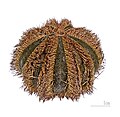 |
Mespilia globulus |
||||
| Slate pencil urchin | 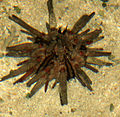 |
Eucidaris tribuloides | ||||
| Purple short spine pincushion urchin |  |
Pseudoboletia maculata | ||||
| Red slate pencil urchin |  |
Heterocentrotus mamillatus | ||||
| Reef urchin, Rock boring urchin |  |
Echinometra sp. | ||||
| Variegated urchin |  |
Lytechinus variegatus |
Jellyfish
| Common name | Image | Taxonomy | Reef safe | Care Level | Description | Max size (bell diameter) |
|---|---|---|---|---|---|---|
| Blue Blubber Jellyfish |  |
Catostylus mosaicus |
No | Expert | This jellyfish actually ranges in color from white to dark purple to reddish brown. It has a dome-shaped bell which pulses at a quick, steady pace, making these jellyfish strong, active swimmers. | 25 cm (9.8 in) |
| Moon jellyfish |  |
Aurelia aurita | No | Moderate to Difficult | A whitish to clear jellyfish with a large dinner-plate shaped bell. They have a fringe of short tentacles around the edge of the bell, and four longer oral arms extending from around the mouth. | 50 cm (19.7 in) |
| Sea Nettles |  |
Chrysaora sp. | No | Expert | Range in color from white to striped orange and brown to purplish. Long tentacles trail behind the bell, sometimes for several meters. | 30 cm (11.8 in) |
| Upside Down jellyfish |  |
Cassiopea sp. | No | Expert | This jellyfish has a somewhat green or grayish blue coloration due to symbiotic algae living in its tissues. It resides on the bottom, exposing its tentacles (and the algae inside them) to the light. very similar to coral in behavior | 30 cm (11.8 in) |
Mollusks
Bivalves
| Common name | Image | Taxonomy | Reef safe | Care Level | Description | Max size |
|---|---|---|---|---|---|---|
| Atlantic Thorny oyster |
 |
Spondylus americanus | 10 cm (3.9 in) | |||
Bear paw clam |
 |
Hippopus hippopus | ||||
| Blue clam, Boring clam |
 |
Tridacna crocea | Yes | 15 cm (5.9 in) | ||
China clam |
Hippopus porcellanus | |||||
| Electric flame scallop |  |
Ctenoides ales | Yes | |||
Flame scallop |
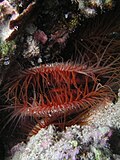 |
Ctenoides scaber | Yes | 3 in (7.6 cm) | ||
Fluted giant clam |
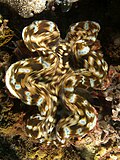 |
Tridacna squamosa | Yes | Moderate? | 40 cm (15.7 in) | |
| Flying scallop | Promantellum vigens | |||||
| Gigas aka "Giant" clam |  |
Tridacna gigas |
Yes | 120 cm (47.2 in) | ||
| Maxima clam |  |
Tridacna maxima |
Yes | Moderate | 20 cm (7.9 in) | |
Southern giant clam |
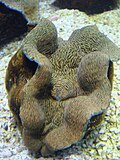 |
Tridacna derasa | Yes | 60 cm (23.6 in) | ||
Thorny oyster |
 |
Spondylus sp. |
Gastropods
| Common name | Image | Taxonomy | Reef safe | Care Level | Description | Max size |
|---|---|---|---|---|---|---|
| Abalone |  |
Haliotis sp. | Yes | Easy | 12 cm (4.7 in) | |
| Arabian Cowrie |  |
Cypraea arabica |
10 cm (3.9 in) | |||
| Astraea snail |  |
Astraea sp. | Yes | Easy | 2.5–10 cm (1.0–3.9 in) | |
| Bumble bee snail[15] |  |
Engina mendicaria | Yes | Easy | 1.5 cm (0.6 in) | |
| Cerith snail | 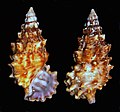 |
Cerithium sp. | Yes | Easy | 3.5 cm (1.4 in) | |
| Gold ring cowrie |  |
Cypraea annulus |
5 cm (2.0 in) | |||
| Lettuce sea slug |  |
Elysia sp., usually Elysia crispata | Yes | Moderate | A chloroplasts into their cells. Color ranges from brownish to green, and can include blues, yellows, and pinks. |
5 cm (2.0 in) |
| Nassarius snail |  |
Nassarius sp. | Yes | Easy | 2.5 cm (1.0 in) | |
| Queen conch |  |
Eustrombus gigas |
Yes, but may knock over loose rocks and coral. | 30 cm (11.8 in) | ||
| Sand conch |  |
Strombidae | ||||
| Sea Hare |  |
sp. | Yes | Expert | 4–10 cm (1.6–3.9 in) | |
| Tiger cowrie, |  |
Cypraea tigris | 15 cm (5.9 in) | |||
| Turbo snail |  |
Turbo sp. | Yes | Easy | 5–10 cm (2.0–3.9 in) |
Cephalopods
Sea anemones
| Common name | Image | Taxonomy | Reef safe | Care Level | Description | Max size |
|---|---|---|---|---|---|---|
| Aptasia |  |
Aiptasia sp. | No | A common pest species in marine aquariums which spreads rapidly and harms corals and invertebrates with their sting. Can sting fish, but fatalities are rare. Notoriously difficult to eradicate, but a number of organisms can be used for control, including peppermint shrimp and Berghia verrucicornis . |
||
| Bubble-tip anemone |  |
Entacmaea quadricolor |
With caution | Moderate | A relatively easy to keep anemone species, it is very colorful, and has distinctive bubble-like swellings on the tips of its tentacles. | 30 cm (11.8 in) |
| Condy anemone[16] | 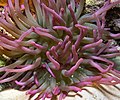 |
Condylactis gigantea | With caution | Moderate | Common anemone species in the aquarium trade. The base color is usually brown to white, often with color on tentacle tips. Many color variations exist, including magenta, purple, yellow, and green. | 15 cm (5.9 in) |
| Delicate sea anemone[17] |  |
Heteractis malu | With caution | Difficult | Also known as the malu anemone or white sand anemone. Color tipped tentacles reach 4 cm in length. This anemone should not be placed on a rock, it prefers a sandy substrate to bury its base in. | 20 cm (7.9 in) |
| Long tentacled anemone |  |
Macrodactyla doreensis | With caution | Moderate | 50 cm (19.7 in) | |
| Magnificent anemone |  |
Heteractis magnifica | With caution | Expert | One of the most difficult anemone species to keep healthy in captivity. | 1 m (3.3 ft) |
| Rock flower anemone |  |
Phymanthus crucifer | With caution | Moderate | ||
| Tube anemone | 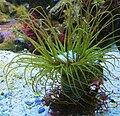 |
Cerianthus sp. | Yes | Moderate | Not a true anemone (actinarian), but a member of the order Ceriantharia . Can make a very colorful aquarium specimen, colored with pinks, purples and sometimes shades of fluorescent green. |
Sponges
| Common name | Image | Taxonomy | Reef safe | Care Level | Description | Max size |
|---|---|---|---|---|---|---|
| Ball sponge | Cinachyra allocladia | Yes | Expert | |||
| Branching vase sponge |  |
Callyspongia vaginalis |
Yes | Expert | ||
| Bee sponge |  |
Acanthella sp. | Yes | Expert | ||
| Orange ball sponge | Cinachyra kuekenthali | Yes | Expert | |||
| Orange fan sponge | Axinella bookhouti | Yes | Expert | |||
| Red ball sponge |  |
Dragmacidon lunaecharta | Yes | Expert | ||
| Red tree sponge | 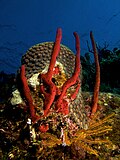 |
Amphimedon compressa | Yes | Expert | ||
Pineapple Sponge |
 |
Sycon | Yes | Commonly regarded as a pest species |
Tunicates
| Common name(s) | Image | Taxonomy | Reef safe | Care Level | Description | Max size |
|---|---|---|---|---|---|---|
| Blue lollipop tunicate[18] |  |
Nephtheis fascicularis |
Yes | Expert | 7.5 cm (3.0 in) | |
| Golden sea squirt, Ink-spot sea squirt[18] |  |
Polycarpa aurata | Yes | Moderate | 15 cm (5.9 in) |
See also
- List of marine aquarium fish species
- List of marine aquarium plant species
- List of freshwater aquarium invertebrate species
- List of brackish aquarium invertebrate species
- Marine aquarium
- Reef aquarium
References
- ^ a b c Sprung, Julian (14 August 2002). "Aquarium Invertebrates: Featherdusters In The Aquarium". Advanced Aquarist. Pomacanthus Publications, LLC. Retrieved 14 December 2014.
- ^ "Cluster Duster (Bispira brunnea)". AquariumDomain.com. AquariumDomain.com. Retrieved 14 December 2014.
- ^ Goemans, Bob. "Marine Spiders (Sea Spiders)". saltcorner.com. Retrieved 26 November 2014.
- ^ a b c Sprung, Julian (14 October 2002). "Aquarium Invertebrates: Mushrooms, Elephants Ears, And False Corals: A Review Of The Corallimorpharia". Advanced Aquarist. Pomacanthus Publications, LLC. Retrieved 4 December 2014.
- ^ a b Borneman, Eric. "Venomous Corals: The Fire Corals". Reefkeeping Magazine. Reef Central, LLC. Archived from the original on 3 November 2014. Retrieved 13 December 2014.
- ^ de Vries, Joost (10 October 2012). "Tubastraea micrantha, the Black Sun, is the most majestic Azoox coral". Reef Builders. Reef Builders, Inc. Retrieved 10 December 2014.
- ^ "Elegance Coral". FishChannel.com. I-5 Publishing, LLC. Retrieved 13 December 2014.
- ^ a b Fatherree, James W. (3 October 2012). "Aquarium Corals: Corals of the Genus Euphyllia". Advanced Aquarist. Pomacanthus Publications, LLC. Retrieved 4 December 2014.
- ^ Fatherree, James W. (14 December 2011). "Aquarium Corals: A Look at the Sun Corals". Advanced Aquarist. Pomacanthus Publications, LLC. Retrieved 4 December 2014.
- ^ Hanley, Charles J. "Why Duncan, Your Whiskers are Tickling my Corallite!". QualityMarine.com. Quality Marine. Retrieved 13 December 2014.
- ^ Thein, Than. "The Perfect Beginner SPS Coral: Seriatopora (Bird's nest)". Saltwater Smarts. Saltwater Smarts. Retrieved 13 December 2014.
- ^ Dana Riddle. "Montipora digitata: A Stony Coral for All Hobbyists". Advanced Aquarist. VII (January 2008).
- ^ "Staghorn Coral". Animal-World.com. Animal-World. Retrieved 13 December 2014.
- ^ a b Fatherree, James W. "The Stoloniferans: Clove Polyps, Star Polyps, and Pipe Organ Corals". Saltcorner. Retrieved 4 December 2014.
- ^ "Bumblebee Snail". Microcosm Aquarium Explorer. Microcosm, Ltd. Retrieved 23 November 2014.
- ^ "Condy Anemone - Condylactis gigantea". Fishlore.com. Fish Lore.com. Retrieved 27 November 2014.
- ^ "Delicate Sea Anemone". Animal-World.com. Animal-World. Retrieved 28 November 2014.
- ^ a b Fatherree, James W. "An Introduction to Tunicates". Reefs.com. Reefs Magazine. Archived from the original on 14 December 2014. Retrieved 14 December 2014.
- Alderton, David (2005). Encyclopedia of Aquarium and Pond Fish (Second ed.). DK Publishing, Inc. pp. 286–297. ISBN 9780756636784.
- Lougher, Tristan (2008) [First Published 2007]. What Invertebrates?: A Buyer's Guide for Marine Aquariums. What Pet? Books Series. Barron's Educational Series, Inc. ISBN 978-0-7641-3741-9. LCCN 2006933016.



